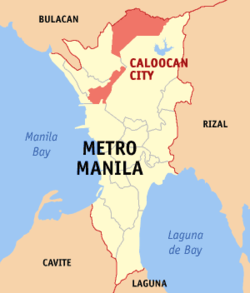Caloocan
| Caloocan | ||
|---|---|---|
| Highly-Urbanized City | ||

The north end of EDSA in Caloocan
|
||
|
||
| Motto: Moving from Vision to Victory | ||
 Map of Metro Manila showing the location of Caloocan City |
||
| Location within the Philippines | ||
| Coordinates: 14°39′N 120°58′E / 14.65°N 120.97°ECoordinates: 14°39′N 120°58′E / 14.65°N 120.97°E | ||
| Country | Philippines | |
| Region | National Capital Region | |
| Province | none (Former part of Rizal province until 1975) | |
| Districts | 1st and 2nd Districts of Caloocan City | |
| Incorporated (town) | 1815 | |
| Cityhood | 16 February 1962 | |
| Highly Urbanized City | December 22, 1979 | |
| Barangays | 188 | |
| Government | ||
| • Mayor | Oscar Malapitan (UNA/NP) | |
| • Vice Mayor | Macario Asistio III (PMP) | |
| • Representative, 1st District | Dale Gonzalo Malapitan (LP) | |
| • Representative, 2nd District | Edgar Erice (LP) | |
| • Sangguniang Panlungsod | ||
| Area | ||
| • Total | 53.20 km2 (20.54 sq mi) | |
| Population (2015 census) | ||
| • Total | 1,583,978 | |
| • Density | 30,000/km2 (77,000/sq mi) | |
| Time zone | PST (UTC+8) | |
| ZIP code | 1400 for Caloocan City Post Office | |
| Dialing code | +63 (0)02 | |
| Website | www |
|
Caloocan City (Filipino: Lungsod ng Kalookan) is the fourth most populous city in the Philippines. It is one of the 16 cities that comprise the Philippines' National Capital Region of Metropolitan Manila. It was formerly a part of the Province of Rizal of the Philippines' Southern Luzon Region. According to the 2015 census, it had a population of 1,583,978. The city's name is colloquially spelled as Kalookan. It comprises what is known as the CAMANAVA area along with cities Malabon, Navotas, and Valenzuela.
The word caloocan comes from the Tagalog root word lo-ok; kalook-lookan (or kaloob-looban) means "innermost area". The city is bordered by Manila, Quezon City, Malabon, Navotas, Valenzuela, Marilao, Meycauayan and San Jose del Monte in the province of Bulacan.
The city is historically significant because it was the center of activities for the 'Katipunan', the secret militant society that launched the Philippine Revolution during the Spanish occupation of the Philippines. In a house in Caloocan secret meetings were held by Andrés Bonifacio and his men, and it was in the city's perimeters where the first armed encounter took place between the 'Katipunan' and the Spaniards.
In 1899 the city saw heavy fighting in the Philippine–American War, at the Battle of Caloocan and the Second Battle of Caloocan.
...
Wikipedia


